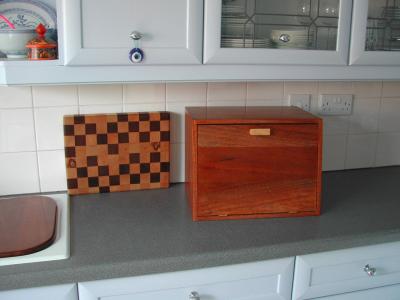I really wouldn't use iroko for this purpose. People vary in their response to this wood but it can start nasty allergies..
"Chlorophora excelsa Benth. & Hook. f.
Iroko, Kambala, African Teak, Moreira, Moule
The timber is strong, durable and weather resistant and is much used for outdoor and indoor constructional work, including boat building.
The alkaloid chlorophorin is an allergic sensitiser (Schulz 1957, 1960, 1962, 1967). The molecule is composed of a four-fold oxidized stilbene nucleus and an aliphatic side chain, and is chemically related to the allergenic compounds of Toxicodendron (King and Grundon 1949, 1950).
Dermatitis affects carpenters, joiners and other wood workers, rather than those felling the trees. The sawdust was recognized as causing dermatitis of eyelids and genitalia, in Breslau over 60 years ago (Czimatis and Hagemann 1910). Iroko is amongst the six commonest causes of dermatitis from woods in France (Zafiropoulo et al. 1968). However the latex oozing from the freshly felled timber appears to be irritant and has caused acute, followed by chronic, dermatitis in East African workers (Piorkowski 1944).
There are numerous reports of dermatitis in wood workers; taken together the reports provide a graphic picture of a severe dermatitis, sometimes associated with ocular and respiratory symptoms, and assuming almost epidemic proportions particularly where high temperature and humidity favour eccrine sweating.
The earliest clinical and chemical studies were made in Germany and France (Hubinot 1928, Frei 1931, 1932, Loro 1923). In an outbreak of dermatitis in a joiners' workshop Jung (1967) noted positive patch test reactions to the sawdust. Goessens (1936) reported a case of generalized dermatitis caused by the sawdust. Frei (1932) obtained positive patch test reactions with sawdust and Ragot and Brun (1948) with an aqueous extract. Thienemann (1941) noted the development of dermatitis in a proportion of workers approximately ten weeks after this wood was first introduced. He gave a good description of the distribution of the dermatitis, which involved the arms, the face and chest and the scrotum. The incidence of dermatitis in some workshops has been very high: in one machine shop all of the more than 50 workers were affected in some degree, though only 9 had severe dermatitis, sometimes accompanied by upper and lower respiratory tract symptoms (Davidson 1941). This variation in the clinical picture was noted also by Langelez (1950); some workers developed only a mild papular prurigo of exposed or covered skin, a few developed dermatitis particularly of the neck and ears, and some in each group had conjunctivitis and asthma.
This variation suggests that the sawdust both irritates and sensitises, and the investigation of a case of dermatitis in a machinist supported this assumption. Patch tests with the dry dust were positive in the patient and in 4 of 5 control subjects, but tests with 0.1% chlorophorin in soft paraffin were positive only in this patient (Beer 1970).
Respiratory symptoms may be severe. Obstructive rhinitis without asthma occurred in men handling iroko and bé té and both rhinitis and asthma in another who worked with iroko, obèche, Triplochiton and framiré (Zafiropoulo et al. 1968). In reporting 11 cases of asthma in men exposed to the dust of iroko and teak (Tectona), Van Ganse (1968) noted that only a proportion of these patients gave positive scratch test reactions and that inhalation tests were sometimes positive when these were negative. It is not established whether the respiratory symptoms are purely irritant in origin or whether a reaginic antibody is implicated.
For patch testing, 1% chlorophorin in soft paraffin is probably suitable, unless this concentration is proved to sensitise some subjects (Maibach 1970). In one patient patch tests with 0.1% chlorophorin were negative, whilst tests to 0.5% and 1.0% were positive (Wilkinson 1969).
Thiel (1960) reported contact sensitivity to the wood.
Kambala was listed by Hublet et al. (1972) and by Oleffe et al. (1975a) as a cause of dermatitis in the Belgian timber industry."





